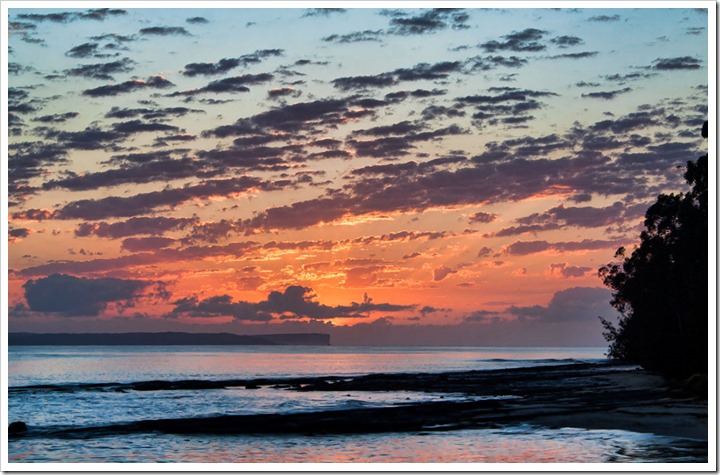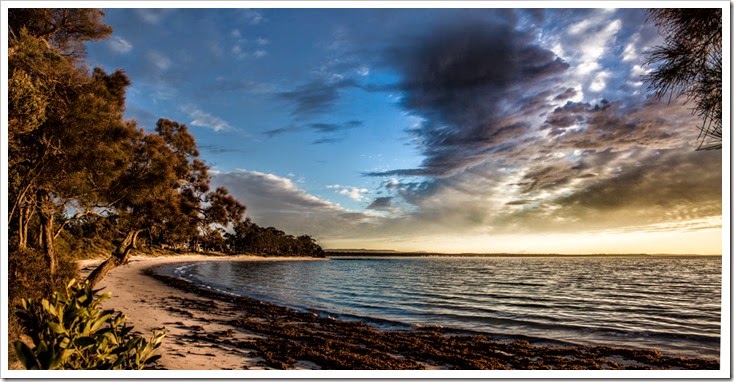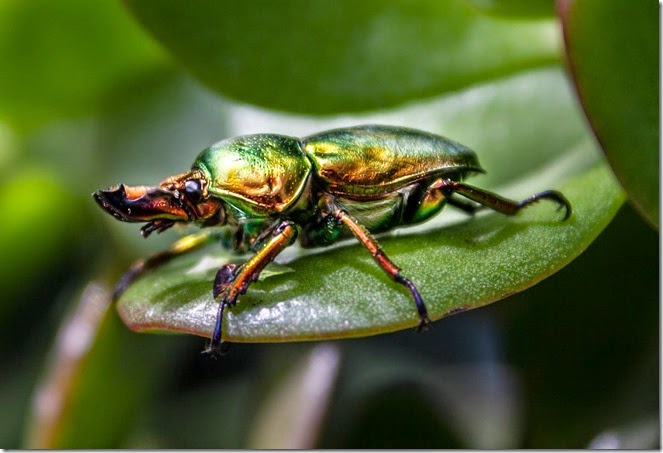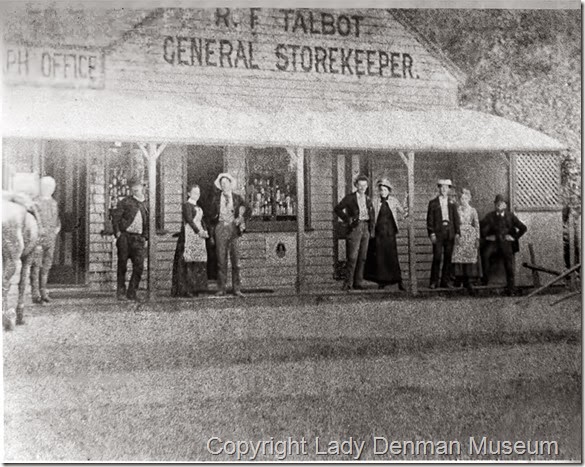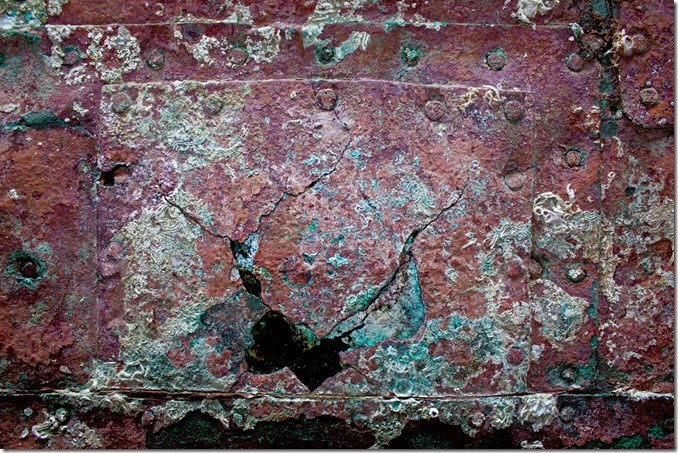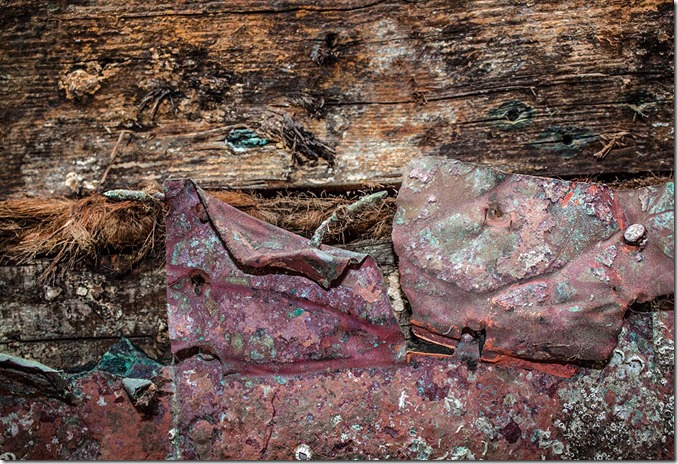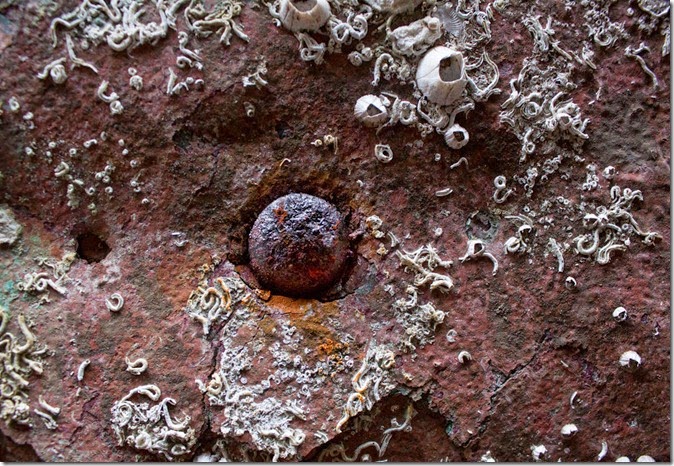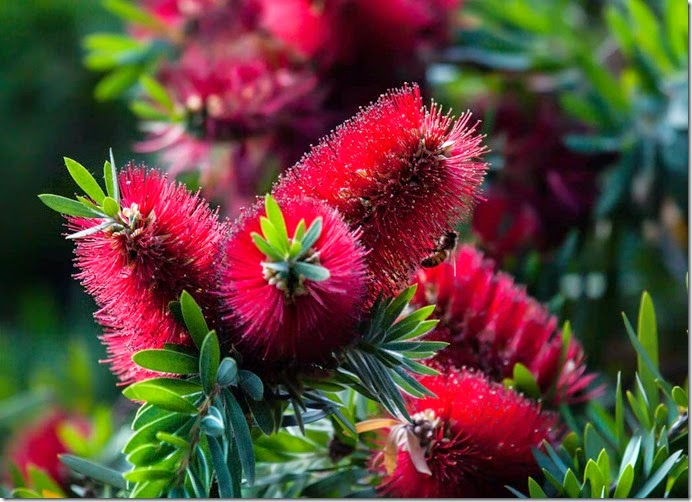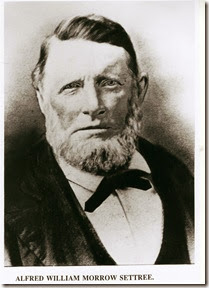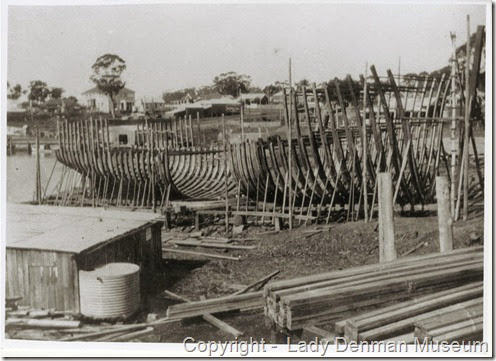29 November 2014
27 November 2014
26 November 2014
The poignant poem by E.Brady…
 |
 Edwin James Brady Edwin James BradyE.J. Brady (1869-1952) was born on 7 August 1869 at Carcoar, New South Wales. He spent much of his childhood in America where his father fought in the Civil War before the family returned to Australia. Extract from the Eden Community Web Site. http://eden.nsw.au/index.php/historical-eden/eden-s-history/e-j-brady |
24 November 2014
The coastal steamer, trouble and strife.
The coastal steamer.
The daily grind of these intrepid little steamers was one of comings and goings.
In and out of harbours with shifting sand banks and fast running tides, loading and unloading cargo and passengers, thousands of sea miles to cover with not much in the way of navigation, communication or weather predicting aids, battling large seas and gale force winds, every trip might be your last.
The captains and crew relied on their experience gained by many hours at sea, for the captain in the wheelhouse and for the crew below the decks of these small cramped ships.
The engineers and crew had to be self sufficient, keeping the engines turning and the ship afloat was their job and their lives often depended on how well they did.
But things happen.
Below are some of the many stories that I have found that made up the life of just one of those coastal steamers.
The S.S. Mokau.
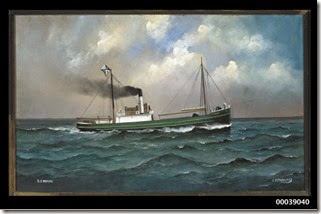 |
| I researched the Mokau for this post because of the previous stories we have covered on this “handy little steamer” which can be found here. |
1904 - December.
The Damaged Steamer Mokau.
The steamer was on her way out to sea from Lismore when she struck the north breakwater inside the Richmond River bar.
She soon floated off however and steamed out to sea, but her steering gear became jammed and rendered the vessel unable to be managed.
The captain found the Mokau was making water fast and attempted to re-enter the river, which he succeeded in doing, but the vessel settled down inside the harbour. A tug went to her assistance and departed with the crew.
Examination found a hole 2ft long just abaft the fore rigging.
At the time she was carrying a cargo of sugar, half of which is thought, will be saved.
1905 – June.
Mokau Alterations.
The steamer Mokau had extensive alterations made to her at Cullen’s Slip. The vessel has been lengthened by 20ft, Cut through at the Iron bulkhead and extensive modifications to the frame, Keelson, scarf's, the side stringers were strengthened on each side by new stringers 60ft long made of ironbark. the story goes on to describe the alterations in more detail than I have provided here.
The end result was an additional carrying capacity of 65 tons and a better sea worthiness.
1907 – June.
Mokau Repaired.
On a trip to Sydney she had to return to Richmond River, crossing the bar at 6.45am after the circulating pump was carried away effecting repairs.
1908 – February.
Fell from the rigging.
Byron Bay – W. Nelson. a seaman on the steamer Mokau broke his collarbone after falling from the rigging.
1908 – May.
Another Harbour Collision – The Wallaby and the Mokau.
Early in the morning a collision occurred between the steamer Wallaby and the steamer Mokau. The Wallaby left Circular Quay at 4.45am for Milson’s Point and was mainstream five minutes later, when she bumped the Mokau inward bound from Richmond River. The impact was not severe and little damage resulted. One of the planks on the bulwarks of the Mokau was stove in but the Wallaby was uninjured.
1909 – May.
Mishap to the Mokau.
She ran aground on the spit at tweed Heads. She was refloated at 4.30pm and is readiness for sea.
1910 – July.
The Mokau Aground.
Attempting to leave Tweed heads she grounded once again, but was refloated during the night.
1913 – November.
Mokau Engines Broken Down.
While off seal rocks the steamer signaled that her machinery was out of order.
At first no details were available to the owners as to what had happened. Steps would be taken to find out more details and to send whatever assistance might be necessary. All they knew, she was out of control and a menace to navigation.
News eventually came that she had picked up a line on her propeller, she came into port without any more trouble, delaying the steamer for four or five hours.
1914 – February.
Collision – Mokau Strikes the Me-Mel. Ferry boat Sinks.
A sensational smash between the Mokau and the ferry Me-Mel resulting in the Me-Mel sinking in 4 minutes.
The Me-Mel left Darling Street at 20 minutes to 12, and when off the island saw the Mokau coming down the harbour from the bridge.
We were heading straight for the wharf when the Mokau – about ten lengths off – sounded two whistles, intimating that she was going to cross my bows. But I had not the slightest possible chance of swinging around, so I immediately sounded one whistle to indicate I was keeping to my course.
But the Mokau came around and struck the Me-Mel fair in the port side with tremendous force.
We were then about three of four lengths from the wharf, The Me-Mel was sinking rapidly and the water was rushing in. The Mokau helped to push us to the wharf and we landed all the passengers safely, then the Me Mel disappeared.
The captain following in the traditions of the sea, was the last to leave his ship just as it sunk he seized a rope and was hauled on shore.
The Mokau sustained comparatively little damage, she had struck the ferry stern on and cut right into her.
1914 - June.
Steamer Mokau.
Not sure what happened here, but it was reported as.
There is no alteration in the condition of the disabled steamer Moaku, which is about a mile from the Jetty. She has a local boat to keep in communication with the land. Her captain is reported to be improving, but has an injured hand.
1914 – June.
Captain Washed off Bridge.
Clarification of the story above.
On a trip to Byron Bay the steamer had apparently met with heavy weather during the recent gales and was badly knocked about.
She lost her rudder and sustained damage to her decks as a result of the buffeting received in the storm.
Waves broke over the vessel and one washed the Captain off the bridge, he sustained injuries.
Other steamers had a similar story of survival after this storm, one the Coombar, had 64 head of cattle on departure from Ballina , with only 24 surviving the journey to Byron Bay, the rest died on board or were washed overboard.
1914 – June
The Gales – Mokau’s Thrilling Escape.
More about the story above.
She left Richmond River with a crew of 11 and a cargo of Molasses for Sydney.
Off Smokey Cape she met the storm. She sought shelter in Trial Bay, and dropped anchor, but she had to leave through the force of the storm. She was driven to sea and sometime Thursday had her steering gear carried away twice.
Later she lost here deck fittings, wheelhouse and compass. She drifted about hopelessly until the storm subsided. She then made for Byron Bay using an improvised steering apparatus, her coal and rations were very low.
She started to whistle and sent up distress signals, she used improvised morse code to relay her plight.
A rescue life boat eventually reached the vessel and took off the first mate and five seamen and landed them safely.
The Mokau was riding at anchor well, but taking water when they left. The sea abated later on and the men returned to the steamer at 5am and got up steam. The Mokau was towed away by the steamer Kiltobranks.
1914 – June.
The Mokau Damaged.
The Mokau arrived at Byron bay with here decks swept. (Presumably from negotiating the large seas running at the time)The following day one of her boats washed ashore at Byron Bay.
1914 – March.
Marine Collision – Captains Certificate Suspended.
The Captain of the Mokau R.B.Davis had his certificate suspended for 3 months after the collision with the Me-Mel.
The court found that the collision was due to the captain’s wrongful act.
1918 – December.
The Mokau loses her tail shaft.
At 4.30 am the small coasting steamer Mokau put into Trail Bay with the loss of here tail shaft. At present the cause of the accident in unknown.
1919 - July.
Wreck of Mokau Sold.
The well known coastal steamer owned by B.M.Corrigan and Co has been sold to Messrs. Kirton and Earnshaw Ltd. for the south coast trade in connection with their sawmill and fire clay business. The price paid was something like 6000 ponds.
1922 – February.
Steamer Ashore.
After such a long time at sea this and many other vessels needed luck to survive many of their experiences in their daily grind.
The Mokau’s luck eventually ran out and she was wrecked at Sussex inlet in January 1922, she was sold for 300 pounds to Mr W. Watt of Nowra….The cargo of silica was sold for 10 pounds to Mr A.W.Setree.
She was never refloated and eventually broke her back and sunk beneath the sand.
November insects
22 November 2014
Jervis Bay – Bygone days.
A small news item from the Shoalhaven Telegraph April 1933.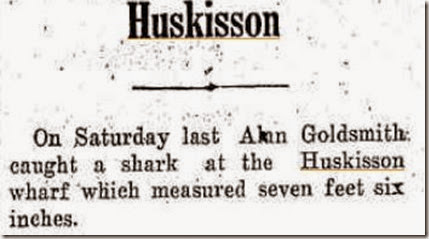
Comment:
From - Unknown.
I'm pretty sure this is one of my uncle's. My grandfather was Ernest Goldsmith. I would love to find out more.
LDMM:
Unfortunately this is the only information about this incident we have been able to find. If you do find any information you think would be relevant to this story, don't hesitate to let us know.
21 November 2014
Mokau. Links and Relations.
![[header%255B4%255D.png]](http://lh3.ggpht.com/-Szvf_qKCXhI/U3VwWqk7V8I/AAAAAAAAE6U/8guKx5fDjOM/s1600/header%25255B4%25255D.png) I had a interesting meeting with Sue Rogers recently at the museum. Sue is a descendant of Batholomew Corrigan owner of the Mokau that was wrecked at the mouth of Sussex Inlet in 1922 and reappeared above the sand earlier this year, allowing me to do a couple of dives on the wreck and shoot some video before disappearing again.
I had a interesting meeting with Sue Rogers recently at the museum. Sue is a descendant of Batholomew Corrigan owner of the Mokau that was wrecked at the mouth of Sussex Inlet in 1922 and reappeared above the sand earlier this year, allowing me to do a couple of dives on the wreck and shoot some video before disappearing again.
Sue had found the post that Id done on the wreck of the Mokau and was excited to finally get a chance to come along to the museum, meet up and to see the other artifacts the museum has relating to the Mokau.
Since then another descendant, Patricia from Ireland, has been in contact excited with discovering the information on the Corrigan’s on the blog. We have put Sue and Patricia in contact with each other, Sue has a book written by her grandfather about the Mokau, which someday Sue has promised to bring along to the museum for me to read.
So the story continues. It's been the highlight of doing the blog for me so far.
Link to the story of the Mokau that started this journey.
General store at Wandandian.
| I remember this store next to the highway at Wandandian, do you? Wandandian - It has been suggested to be a corruption of Aboriginal word 'Wandrawandian' meaning - 'home of the lost lover'. The area as described back in the 1840’s. ”The area was in a rough state then, and there was no room for men unless they had strong hearts and strong arms to battle with the existing circumstances” ”The saws merry hum resounds through the bush indicative of industry and enterprise”. Wandandian had a thriving timber industry, Bullock teams would haul timber to the timber mill and then after milling it would be conveyed by means of a tram line to the banks of Wandandian Creek, which was dredged to allow small steamers to be loaded and shipped down to St Georges head for shipping to Sydney. 1903. Mr A. Jennings established the first saw mill and it was expected to attract many people to the area. It was now hoped the department of Public Instruction will redeem their implied promise and give a full time public school. it is expected that at least 20 additional families will shortly be located here. 1906. An article in the Shoalhaven Telegraph described the expansion of the timber industry at Wandandian. When Allen Taylor and Co bought the existing mill from Mr A. Jennings the mill was expanded, teams of log haulers and up to thirty five good sleeper getters were advertised for. It was expected to employ several hundred men over the next few years , the whole district must benefit with the introduction of extra capitol and employment of so many men. Two new steamers were acquired for the task of moving the timber, with orders for timber as far away as Japan and Germany to be supplied. The steamers were well known in the district, plying back and forth across the basin and along the Sussex Inlet river loaded with timber. |
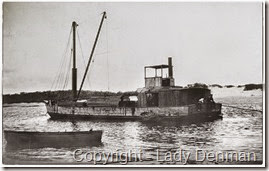 | 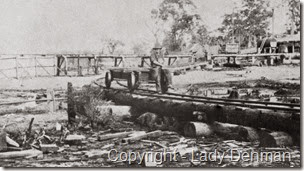 |
| The small steamer The Advance | Tracks at saw mill. |
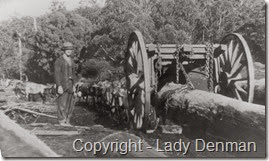 | 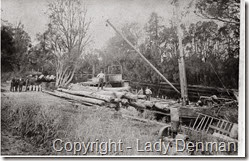 |
| Bullock team | Advance being loaded at Wandandian. |
Wandandian still has a small timber mill, Wandandian Creek has become quiet once again, Steamers have been replaced with trucks and the neighborhood no longer rings with the sound of axes.
The general store as seen above has gone and a new wine outlet stands in it’s place. 
20 November 2014
Newsletter
Click here for the latest information about the museum, most interesting.
. There’s news about the Halloran Collection.
. A rundown of recent exhibitions and the present exhibition.
. More news pertaining to the solar panel investment.
. There’s an interesting story on the Crest restoration. it’s a credit to the people involved.
Lady Denman Museum – It feels good to be green!
Power consumption has been one of the museum’s greatest expenditures.
With a large capital investment the museum has had solar cells installed over the two main exhibition buildings, this will provide all the power the museum will need for lighting, computers, displays, monitors, etc, The museum has been slowly investing in power saving measures for quite some time now and the results have been outstanding.
With the new solar arrays on the roof the Museum has become not only self sustaining but can now be classed as an an environmentally friendly establishment… It feels good to be green!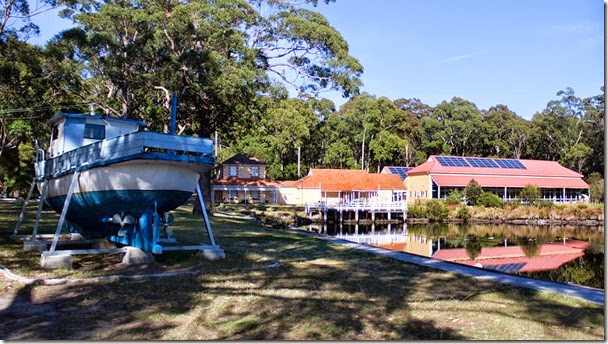
| Follow this LINK to see a live display, showing how much power the cells are generating and our green credentials….most interesting. https://easyview.auroravision.net/easyview/index.html?entityId=4362510 |
Barnacle encrusted hull.
Across the hull of the Denman you will see patches of dried barnacles and tube worms. This shows how the copper works to help protects the hull from damage from marine organisms.
The copper acts as a sacrificial layer and because of the copper component slows the rate at which marine organisms will attach themselves to the hull.
In more recent times copper based anti fouling paints were used for the same purpose, but this caused other problems with copper and other chemicals leeching back into the marine environment, this practice has been banned from most developed countries.
Alternatives are available that do the same job but are not bad for other marine organisms.
The problem comes from the gradual buildup slowing the vessels speed and adding greatly to it’s use of fuel.
There was no easy way to remove them, the vessel had to be slipped and the build up of weed, tube worms and barnacles had to be scraped or blasted off with water.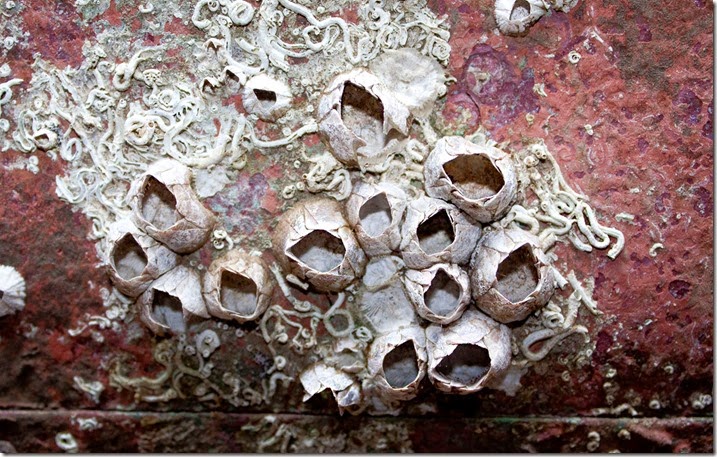
19 November 2014
Windjammers
A rare piece of footage showing life aboard Windjammers in the 1930’s
The exhibition 'Windjammers: The Last Grain Races' is on now at the SA Maritime Museum.
This footage is spliced together from three films in the SA Maritime Museum Collection capturing life on board a windjammer.
Footage was shot by Alan Villiers on 'Parma' in 1933, and on 'Passat' by Thomas Wells in 1938 and 1939 and Jack Wadrop in 1948.
18 November 2014
See the change from then until now.
67 years of service on Sydney Harbour and an adventurous trip back to her birth place Huskisson, has taken it’s toll on the Lady, but she now rests in peace and is enjoyed by thousands of visitors every year.
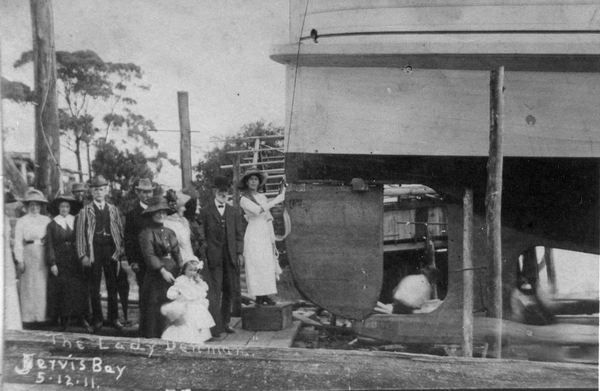
I'm sure many of you have ridden on the Denman when you were children, “I did”……well come along to the museum and take a trip back down memory lane and relive that fantastic experience, stand at the wheel and play captain, ring the ships bell, stroll the curved decks and watch the video presentation about this beautiful and historic boats history.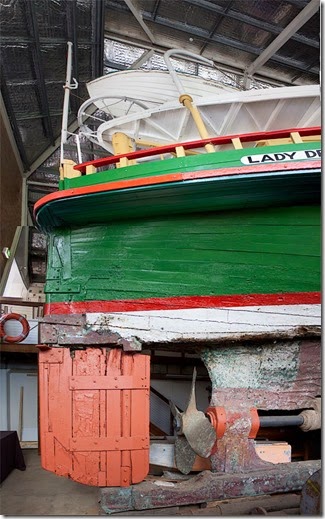
Restoration process continues
This week saw the start of an extensive program of clearing, cleaning and restoration of the museums collection.
The exhibition area that houses the Halloran Collection will be closed to the public while this process is carried out.
The area will be completely cleared of all relics, every relic will be subjected to professional scrutiny and cleaning ensuring this valuable collection will be in pristine condition for many years to come.
This work is a vital part of all museums collection management strategy.
17 November 2014
Divers Pump
Amongst the many amazing relics at the museum you will come across two timber cabinets that might have you puzzled as to their purpose, until you have a closer look at the details that will give away their secrets.
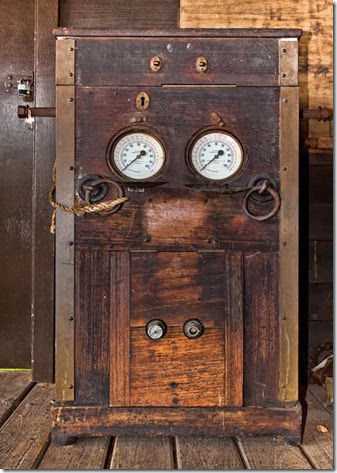 |
| This is a pump that could provide air for two divers. |
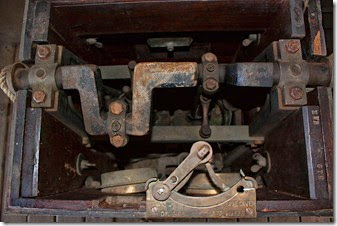 |
| Inside detail. |
 |
| Pressure Gauge. |
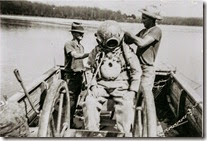 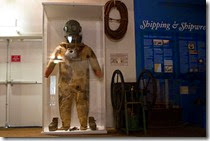 |
| Bill Wray preparing to gather mud oysters from the bed of the Clyde River. The suit, helmet, boots and lead weight weigh about 80 killograms. This beautiful display can be seen in the museum.. |
| http://ourtownourpeople.com/www.ourtownourpeople.com/55._The_Wray_Family.html |
| http://www.ladydenman.asn.au/newsletters/2011/feb.pdf |
14 November 2014
The steamer Trident

The heading as it appeared in the Australian Town and Country Journal Saturday September 15th 1894.
Specifications.
68 gross ton timber screw steamer Trident built by George Dent Jnr of Huskisson in 1886 length 84ft, beam 18ft with a 6ft deep hold capable of 8 knots.
Owned by the Moruya Steam Navigation Company.
Moruya Bar.
A narrow passage of about 60 yards with a long breakwater on the northern side and shallow reefs and sand bars on the southern side, swift tide changes creating strong currents working against the sea, sand build up creating breaking bars of water across the entrance. Add a rough and rolling sea and it can be a difficult and disastrous place for any vessel to enter.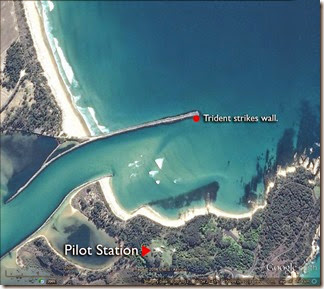
September 5th 4.pm. she left Sydney and had an uneventful trip making good time south carrying general cargo and passengers.
September 6th 10.30 am. Captain Stephen Canty had been in command for the last 4 years.
When she arrived at the entrance to Moruya river the sea was rough with a heavy north easterly swell across the bar.
‘Wait till high tide”.
At the time of the Tridents arrival the pilot signaled to him, ‘Wait till high tide”. It was high tide at 12.30pm by the Almanac, and about a quarter of an hour before then the ‘signal to stand in was hoisted”
September 6th 12.30pm.
All hands made ready to enter the bar, at a critical time during the entry her stern was lifted high out of the water, the effect being that the rudder had no hold on the water and the propeller raced, the steamer refused to answer her helm and “broached-to”, two seas broke over her in quick succession, before she had time to recover she was dashed onto the rocks on the northern end of the breakwater and the bottom knocked out of her.
“Being glad to escape with their bare lives”.
Captain Canty gave the necessary orders to the engine room to back off and they were promptly obeyed.
When the vessel was being driven in, he gave the orders to launch the boat, The captain and one crew stayed on board, all other hands including 5 passengers entered the boat and were saved, they lost everything, being glad to escape with their bare lives.
Captain Canty and the before mentioned seaman had to swim for it.
The vessel sank in about 20ft of water, her hull being completely covered, and nothing but her masts, funnel and the coverings of the bridge visible.
She was later raised, the hull was found to be so injured she was not worth repairing.
 |
| Wednesday 7th August 1995. Evening news Sydney. Blown up with dynamite. |
 |
| Meanings. Almanac An almanac (also archaically spelled almanack and almanach) is an annual publication that includes information such as weather forecasts, farmers' planting dates, tide tables, and tabular information often arranged according to the calendar. Astronomical data and various statistics are found in almanacs, such as the times of the rising and setting of the sun and moon, eclipses, hours of full tide, church festivals, and so on. Broached – to. A boat broaches when its heading suddenly changes towards the wind due to wind/sail or sea interactions for which the rudder cannot compensate. This causes the boat to enter a Death roll, rolling dangerously and if not controlled may lead to a capsize and turning turtle. Helm. A ship's steering mechanism, ship's wheel. Bulwark. Something that provides protection for or against something. A wall that is part of a ship’s sides and that is above the ships upper decks. 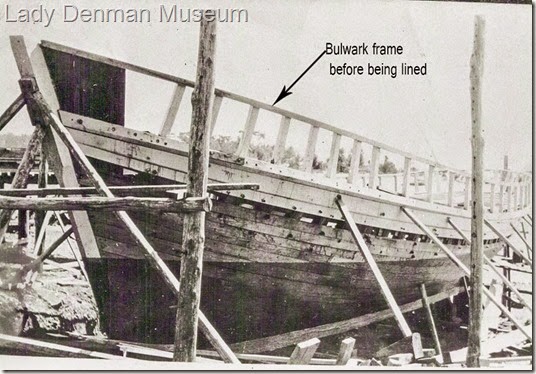 |
| Ref: Trove |
A previous cheesy incident.
As reported in the National Advocate Bathurst, Thursday 25th June 1891.
During what was described as a terrific hurricane along the south east coast, the steamer Trident put into Ulladulla Harbour for shelter, with one of her masts blown out and the Bulwarks stove in.
The beach was strewn with cheese of which her cargo consisted.
13 November 2014
Lady Denman Hull.
Lady Denman Hull.
| The original spotted gum used in the hull construction with part of the copper sheeting used to protect the hull from damage from timber borers. You can clearly see the matted oakum fibre, which comes from coconuts, this was tamped with a caulking iron. Tar or pitch was then used to seal between each plank, making it watertight, You can also see the copper nails used to fix the copper sheet.. |
11 November 2014
Lady Denman still alive.
103 years after it’s construction the Lady is still undergoing change.
26 years after the Lady finally came to rest within the Museum and underwent extensive restoration, the copper sheeting that lines the hull is still changing to it’s surrounding environment.
I will post a few photographs of small sections of the hull, the colours and structure are like small works of art.
I hope you find it as fascinating as I do.
Click on the image to enlarge to see the full impact.
Lady Denman Museum Flowers in November.
The iconic Flannel Flower ( Actinotus helianthi )
Is flowering wonderfully in the grounds of the Lady Denman at the moment.
A few facts you might not know…..A member of the carrot family. Its generic name, meaning "furnished with rays"
it’s generally a herbaceous scrub growing to around 18 inches high but sometimes up to 5ft.
Can be grown from seed or cuttings.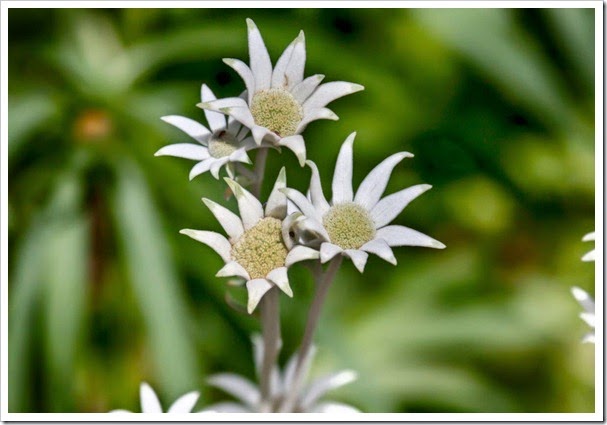
10 November 2014
Wreck of the Relic
Foundered in calm seas on the North East coast of Tasmania.
Following on from the previous post.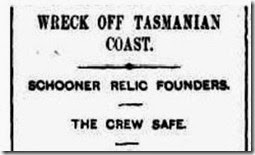 Launched at Huskisson in 1903 as the Reliance and later renamed as the Relic.
Launched at Huskisson in 1903 as the Reliance and later renamed as the Relic.
A 93ft wooden topsail schooner of 113 tons register built by Henry Dent.
For some years she had been continuously employed in the timber trade between Melbourne, Adelaide and Hobart.
Headline announcing the wreck in the Hobart Mercury.
Tuesday March 29th, 1910
At the time of it's foundering it was being used to ship 62.00ft of timber for the Hobart Timber Company from Adventure Bay to Adelaide.
The Captain Chas, J, Brown originally intended to to proceed via the west coast but weather conditions evidently necessitated she travel in the opposite direction.
Saturday 2nd April.
North of Eddystone she ran into bad weather and sort shelter in the Bay of Fires.
7 o’clock
The Eddystone lighthouse keeper reported her passing south at 7 O’clock.
10.30am
A telegram was received at the office of the Hobart Marine Board by superintendent Neilson, of Eddystone lighthouse reporting the wreck of the schooner Runic, but the name was subsequently corrected to Relic.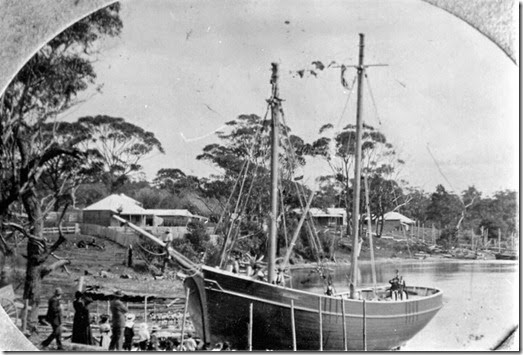
The Reliance at Huskisson 1903, renamed the Relic ready for launch.
She has struck a rock and is sinking fast.
It was reported she had struck a submerged rock while passing inside of Eddystone Rock and the impact so great as to at once place the vessel in great danger.
The captain attempted to beach the vessel, but it was sinking fast, realising there was no hope of saving her, he ordered the crew to the boat which was carried.
She foundered shortly afterwards in deep water, leaving only the topmast showing out of the water.
No difficulty was experienced getting the crew in the vessels boat and ashore, but they lost most of their belongings,
the crew had landed at Eddystone Point some three-quarters of a mile from the scene of the wreck.
The sea was calm but hazy with a moderate W.S.W wind and sea.
The crew were picked up by the steamer Koonookarra and arrived at Launceston Tasmania on the 6th of April.
She had been stranded before.
In 1904 At this time she was owned by Mr James Dent of Huskisson, the vessel went ashore at Adventure Bay, and was bought as she lay by the Current Owners Messrs, Grey Bros who refloated her and repaired her.
Eddystone Point.
81ft high is the extreme N.E point of Tasmania forming the northern point of the Bay of Fires.
There have been several wrecks in the vicinity of the Relic.
Vessel Specs:
Formally owned by Mr Games Dent, shipbuilder of Huskisson, Jervis Bay.
Owner, Messrs. Grey Bros, Hobart
113 tons
Length, 93ft.4inches
Beam, 23ft. 9 inches
Depth, 7ft. 7 inche
Insured by the New Zealand Insurance Company for 1000 pounds.
9 November 2014
The real story.
The joy of History as it comes to life.
Articles come to life that help verify information we have attached to certain historic photographs.
As time passes information is lost, other information comes from vague memories, through research we can sometimes get lucky and add some clarity to a photograph.
This is an example, there was some confusion as to the name of this vessel seen below.
The records attached to this photograph in the Museums collection state that it showed the Dove on the shores of Huskisson.
Research has shown that it was actually the Reliance later to be renamed the Relic.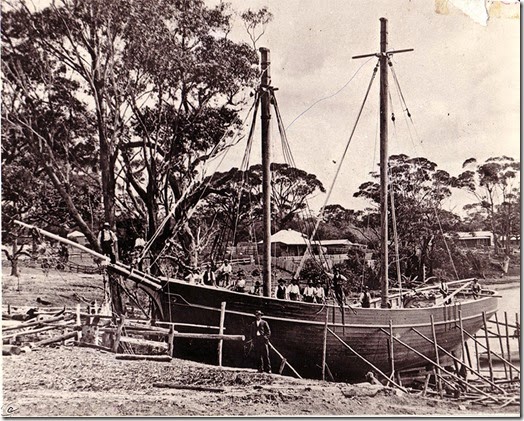
Original photograph titled the Dove prior to launch.
Evening News Saturday 22 July 1905.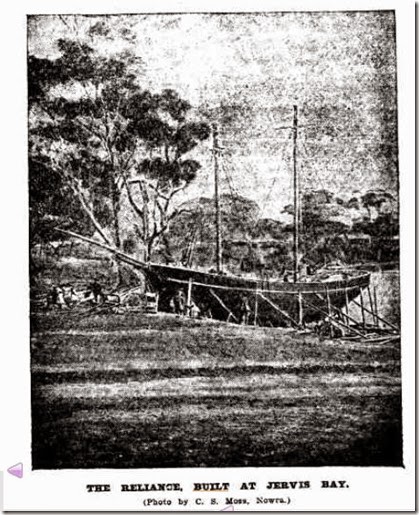
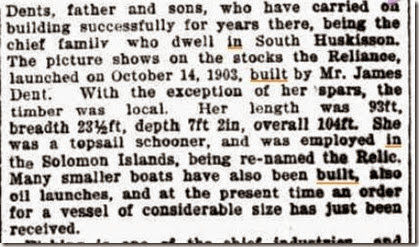
REF” http://trove.nla.gov.au/ndp/del/article/114461985?searchTerm=ships%20built%20in%20jervis%20bay&searchLimits=

